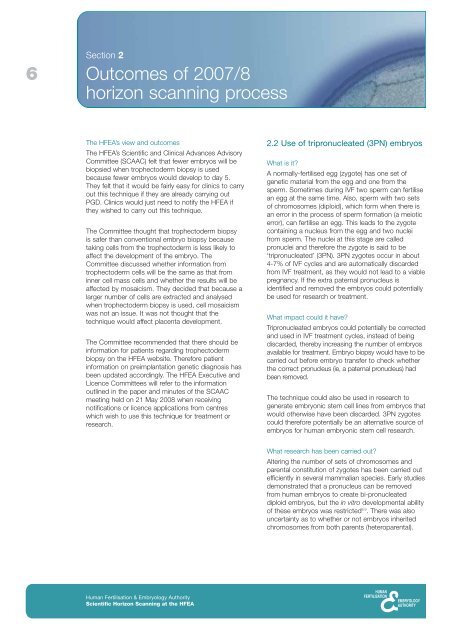Annual report 2008/09 - Human Fertilisation & Embryology Authority
Annual report 2008/09 - Human Fertilisation & Embryology Authority
Annual report 2008/09 - Human Fertilisation & Embryology Authority
Create successful ePaper yourself
Turn your PDF publications into a flip-book with our unique Google optimized e-Paper software.
6Section 2Outcomes of 2007/8horizon scanning processThe HFEA’s view and outcomesThe HFEA’s Scientific and Clinical Advances AdvisoryCommittee (SCAAC) felt that fewer embryos will bebiopsied when trophectoderm biopsy is usedbecause fewer embryos would develop to day 5.They felt that it would be fairly easy for clinics to carryout this technique if they are already carrying outPGD. Clinics would just need to notify the HFEA ifthey wished to carry out this technique.The Committee thought that trophectoderm biopsyis safer than conventional embryo biopsy becausetaking cells from the trophectoderm is less likely toaffect the development of the embryo. TheCommittee discussed whether information fromtrophectoderm cells will be the same as that frominner cell mass cells and whether the results will beaffected by mosaicism. They decided that because alarger number of cells are extracted and analysedwhen trophectoderm biopsy is used, cell mosaicismwas not an issue. It was not thought that thetechnique would affect placenta development.The Committee recommended that there should beinformation for patients regarding trophectodermbiopsy on the HFEA website. Therefore patientinformation on preimplantation genetic diagnosis hasbeen updated accordingly. The HFEA Executive andLicence Committees will refer to the informationoutlined in the paper and minutes of the SCAACmeeting held on 21 May <strong>2008</strong> when receivingnotifications or licence applications from centreswhich wish to use this technique for treatment orresearch.2.2 Use of tripronucleated (3PN) embryosWhat is it?A normally-fertilised egg (zygote) has one set ofgenetic material from the egg and one from thesperm. Sometimes during IVF two sperm can fertilisean egg at the same time. Also, sperm with two setsof chromosomes (diploid), which form when there isan error in the process of sperm formation (a meioticerror), can fertilise an egg. This leads to the zygotecontaining a nucleus from the egg and two nucleifrom sperm. The nuclei at this stage are calledpronuclei and therefore the zygote is said to be‘tripronucleated’ (3PN). 3PN zygotes occur in about4-7% of IVF cycles and are automatically discardedfrom IVF treatment, as they would not lead to a viablepregnancy. If the extra paternal pronucleus isidentified and removed the embryos could potentiallybe used for research or treatment.What impact could it have?Tripronucleated embryos could potentially be correctedand used in IVF treatment cycles, instead of beingdiscarded, thereby increasing the number of embryosavailable for treatment. Embryo biopsy would have to becarried out before embryo transfer to check whetherthe correct pronucleus (ie, a paternal pronucleus) hadbeen removed.The technique could also be used in research togenerate embryonic stem cell lines from embryos thatwould otherwise have been discarded. 3PN zygotescould therefore potentially be an alternative source ofembryos for human embryonic stem cell research.What research has been carried out?Altering the number of sets of chromosomes andparental constitution of zygotes has been carried outefficiently in several mammalian species. Early studiesdemonstrated that a pronucleus can be removedfrom human embryos to create bi-pronucleateddiploid embryos, but the in vitro developmental abilityof these embryos was restricted 8 9 . There was alsouncertainty as to whether or not embryos inheritedchromosomes from both parents (heteroparental).<strong>Human</strong> <strong>Fertilisation</strong> & <strong>Embryology</strong> <strong>Authority</strong>Scientific Horizon Scanning at the HFEA
















